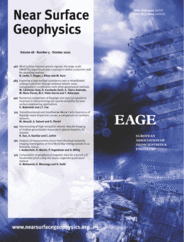-
oa Wind turbine induced seismic signals: the large‐scale SMARTIE1 experiment and a concept to define protection radii for recording stations
- Source: Near Surface Geophysics, Volume 18, Issue 5, Sep 2020, p. 467 - 482
-
- 27 Nov 2019
- 24 May 2020
- 25 Jun 2020
Abstract
Wind turbines produce mechanical energy that can propagate to the ground and disturb sensitive measurements such as seismic recordings. The aim of the large‐scale experiment Seismic Monitoring And Research of wind Turbine Induced Emissions (SMARTIE1) at a single wind turbine in Pfinztal (SW Germany) is to understand how wind turbines emit seismic signals under different operating conditions and how these seismic signals propagate through the local subsurface. The main objectives of SMARTIE1 are the investigation of wind turbine induced seismic signals, the characteristics of their propagation behaviour, as well as the radiation pattern of a single wind turbine as defined using particle motions. Moreover, we quantify the emission of the wind turbine induced seismic signals with respect to the wind speed. The combination of the wind turbine's emission into the subsurface and the attenuation behaviour of the seismic signals (ground motion velocity) can be used to estimate protection radii around seismic stations to ensure the recording of seismic signals without noticeable influences of the wind turbines. In this study, we detect several discrete wind turbine induced frequency peaks ranging from 1 to 10 Hz. We identify a radiation pattern of the wind turbine, which could give further insights into the interaction between the movement of the wind turbine's nacelle and the generation of the wind turbine induced seismic signals. Using profile measurements with a maximum distance of almost 3 km each, we fit a power‐law decay for power spectral density proportional to . The attenuation factor, , ranges from 0.7 to 1.3 for lower frequencies between 1 and 4 Hz, and increases to = 2.3 for the higher frequency peak around 5.25 Hz. Finally, we present an example of estimation of a protection radius around the seismic station of the Collm Observatorium that is part of the German Regional Seismic Network. The example protection radius around Collm Observatorium regarding this single wind turbine is reached at a minimum distance of 3.7 km.




